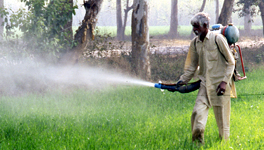 [CSE 16 January 2013] -- The Indian public interest research and advocacy group, Centre for Science and Environment, has published a review of the country’s pesticide regulations. The report examines how and where pesticides are used in the country, the most common human exposure routes, and acceptable and possible daily intakes by people of potentially dangerous pesticides. Of the 234 pesticides registered in India, 59 were found to have no set maximum residue limit (MRL). A review of 11 important crops in India was also undertaken — wheat, paddy, apple, mango, potato, cauliflower, black pepper, cardamom, tea, sugarcane and cotton. The paper shows that the pesticide recommendations made by state agriculture universities, agriculture departments and other boards for these crops do not conform to the pesticides that the Central Insecticides Board and Registration Committee (CIBRC) has registered for those crops. The agriculture universities, departments and boards were found to be recommending many pesticides that have not been registered for some of crops they were being recommended for. An analysis of 10 common pesticides showed that waiting periods for many of their registered uses (crop-pest/weed/disease combination) have not been recommended. Farmers were found to be unaware of the registered uses of pesticides. Farmers most commonly applied pesticides as dealers recommended. Outreach of state agriculture universities and departments to the farmers was minimal.
[CSE 16 January 2013] -- The Indian public interest research and advocacy group, Centre for Science and Environment, has published a review of the country’s pesticide regulations. The report examines how and where pesticides are used in the country, the most common human exposure routes, and acceptable and possible daily intakes by people of potentially dangerous pesticides. Of the 234 pesticides registered in India, 59 were found to have no set maximum residue limit (MRL). A review of 11 important crops in India was also undertaken — wheat, paddy, apple, mango, potato, cauliflower, black pepper, cardamom, tea, sugarcane and cotton. The paper shows that the pesticide recommendations made by state agriculture universities, agriculture departments and other boards for these crops do not conform to the pesticides that the Central Insecticides Board and Registration Committee (CIBRC) has registered for those crops. The agriculture universities, departments and boards were found to be recommending many pesticides that have not been registered for some of crops they were being recommended for. An analysis of 10 common pesticides showed that waiting periods for many of their registered uses (crop-pest/weed/disease combination) have not been recommended. Farmers were found to be unaware of the registered uses of pesticides. Farmers most commonly applied pesticides as dealers recommended. Outreach of state agriculture universities and departments to the farmers was minimal. application-pdf.png